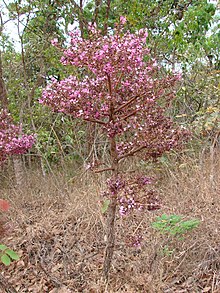Andira
| Andira | |
|---|---|

| |
| Andira humilis | |
| Scientific classification | |
| Kingdom: | Plantae |
| Clade: | Tracheophytes |
| Clade: | Angiosperms |
| Clade: | Eudicots |
| Clade: | Rosids |
| Order: | Fabales |
| Family: | Fabaceae |
| Subfamily: | Faboideae |
| Clade: | Meso-Papilionoideae |
| Clade: | Andira clade |
| Genus: | Andira Lam., nom. cons.[1] |
| Species | |
|
See text. | |
| Synonyms[2] | |
| |
Andira is a genus of flowering plants in the legume family, Fabaceae. It is distributed in the tropical Americas, except for A. inermis, which also occurs in Africa.[3] It was formerly assigned to the tribe Dalbergieae, but molecular phylogenetic studies in 2012 and 2013 placed it in a unique clade within subfamily Faboideae named the Andira clade.[4][5]
Compared to other Faboideae the genus has unusual systems of root nodules[3] and fruits, which are drupes. In most species the fruits are dispersed by bats, and in some they are dispersed by rodents. They may also be dispersed on water.[6]
Plants of the genus are used in
Species
As of April 2023[update], Plants of the World Online accepted the following species:[2]
- Andira anthelmia (Vell.) J.F.Macbr.
- Andira carvalhoi R.T.Penn. & H.C.Lima
- Andira chigorodensis R.T.Penn.
- Andira cordata Arroyo ex R.T.Penn. & H.C.Lima
- Andira coriacea Pulle
- Andira cubensis Benth.
- Andira cujabensis Benth.
- Andira fraxinifolia Benth.
- Andira galeottiana Standl.
- Andira grandistipula Amshoff
- Andira humilis Mart. ex Benth.
- Andira inermis (W.Wright) Kunth ex DC.
- Andira jaliscensis R.T.Penn.
- Andira legalis (Vell.) Toledo
- Andira macrocarpa R.T.Penn.
- Andira macrothyrsa Ducke
- Andira marauensis Mattos
- Andira micrantha Ducke
- Andira multistipula Ducke
- Andira nitida Mart. ex Benth.
- Andira ormosioides Benth.
- Andira parviflora Ducke
- Andira praecox Arroyo ex R.T.Penn.
- Andira spectabilis Saldanha
- Andira surinamensis (Bondt) Splitg. ex Pulle
- Andira taurotesticulata R.T.Penn.
- Andira tervequinata R.T.Penn., Aymard & Cuello
- Andira trifoliolata Ducke
- Andira unifoliolata Ducke
- Andira vermifuga (Mart.) Benth.
References
Wikimedia Commons has media related to Andira.
Wikispecies has information related to Andira.
- JSTOR 1554939.
- ^ a b "Andira Lam". Plants of the World Online. Royal Botanic Gardens, Kew. Retrieved 2023-04-23.
- ^ JSTOR 25027903. Archived from the originalon 2014-02-22. Retrieved 2014-02-14.
- .
- PMID 23221500.
- .
- ^ da Silva VC, de Carvalho MG, da Cunha e Silva SL (2007). "Chemical constituents from roots of Andira anthelmia (Leguminosae)". Rev Latinoamer Quím. 35 (1–2): 13–19. Archived from the original on 2010-05-23.


